Finding DB2 Information Using the Internet
| < Day Day Up > |
| The Internet provides a wealth of easily accessible information for the DB2 professional. The days of IBM-Link being the only place to turn for DB2 information are most decidedly over. Immediate access to volumes of information is readily available for the asking. Now examine some of the best places to look for DB2 information in cyberspace ! Internet ResourcesA wealth of information is available through the Internet. However, it is rather difficult to learn what is available. The most useful Internet resources for DB2 professionals are Usenet Newsgroups, mailing lists, and access to the World Wide Web (WWW). DB2- Related Usenet NewsgroupsThere are newgroups available to satisfy just about every interest, and DB2 usage is no foreigner to Usenet. There are three primary newsgroups that DB2 users can access for DB2 news and information:
Generic database information can be found on the comp.databases newsgroup. Some DB2 users post questions, comments, and information to this newsgroup, but DB2-specific traffic is very light. The bit.listserv.db2-1 newsgroup is relatively active with DB2 discussions and information. At one point in time this newsgroup was a mirror copy of the DB2 mailing list. But no longer. Some messages are duplicates of the mailing list, others are not. The third newsgroup is comp.databases.ibm-db2 . It was instituted in early 1995 to provide a dedicated newsgroup for DB2 users. However, the postings to this newsgroup predominantly pertain to non-z/OS DB2 platforms (primarily for Linux, Unix, and Windows platforms). For a listing of other Usenet Newsgroups that may be of interest to DB2 and DBMS users, see Table 17.1. Table 17.1. Interesting Usenet Newsgroups
The DB2 Mailing ListThe DB2 mailing list is hosted by IDUG ”the International DB2 Users Group . It can be subscribed to by sending a message to the subscription address, LISTSERV@WWW.IDUG.ORG. The message should read as follows : SUBSCRIBE DB2-L NOTE Because the subscription address begins with LISTSERV , the DB2 mailing list is sometimes referred to as the DB2 LISTSERV , or list server. LISTSERV is also the name of the software that manages the mailing list on the server machine. After issuing the preceding command, the list server will send you a message asking you to confirm the subscription. Upon doing so, information will quickly begin flowing into your email box (perhaps at a much quicker rate than you can reasonably digest). Literally, hundreds of messages may be sent to you every week. To sign off of the newsgroup, send the following message to the same subscription address: SIGNOFF DB2-L All of these commands, that is, subscribing and signing off, as well as many others, can be performed on the Web, too. Simply access the DB2-L page at the following link: http://www.idugdb2-l.org/adminscripts/wa.exe?REPORT&z=3 In addition to a subscription address, mailing lists also have a posting address. This is the address to which mailing list posts must be sent. Never send subscription requests to the list's posting address. Correspondingly, never send a post to the subscription address. The posting address for the DB2-L mailing list is DB2-L@WWW.IDUG.ORG. When a message is sent to this address, it will automatically be forwarded to everyone currently subscribed to the list. Postings to the DB2 mailing list are archived so that you can find old messages of interest you might not have saved. Use this link to access the archive of past DB2-L postings: http://www.idugdb2-l.org/archives/db2-l.html If you have a problem or question with the list, or just need some help, you can send an email to DB2-L-REQUEST@WWW.IDUG.ORG for assistance. NOTE Another mailing list that contains useful DB2 and z/OS information is the IBM mainframe mailing list, known as IBM-MAIN . The email address to subscribe to the mainframe list is LISTSERV@BAMA.UA.EDU. To post messages, use the following email address: IBM-MAIN@BAMA.UA.EDU. Additional information about the mainframe mailing list can be found at http://www.mainframes.com/ibm-main.htm DB2 Information on the WebThere are many Web pages providing useful DB2 information. Foremost, of course, is IBM's Web site. The DB2 for OS/390 and z/OS Web page contains a plethora of useful information, and you should most definitely bookmark this page for future reference (see Figure 17.4). From this page, you will be able to access release information, technical information, DB2 manuals online, and additional DB2 product information. Figure 17.4. The IBM DB2 for OS/390 and z/OS page. (http://www.software.ibm.com/data/db2/os390) Another useful IBM site is the Redbook site. IBM's International Technical Support Organization (ITSO) publishes many books on technical topics. The IBM ITSO Redbook site can be accessed at http://www.redbooks.ibm.com/ The Redbook site provides a searchable online catalog, the ability to order redbooks directly from IBM over the Web, and, in many cases, to download redbooks for free in Adobe Acrobat format. Four other Web sites worth checking out and bookmarking are the DB2 USA site, Eric Loriaux's MVS site, DB2 Times, and the DBAzine.com site. Refer to Figures 17.5 through 17.8. These sites are very useful as they contain pages of links to other DB2-related sites and stories, as well as original content in some cases. Figure 17.5. The DB2 USA Web site. ( http://db2usa.hypermart.net/eliendb2.htm )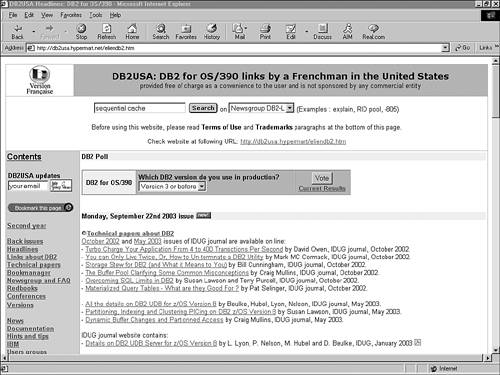 Figure 17.8. The DBAzine.com Web Portal. (http://www.dbazine.com) Many DB2 experts and consultants have their own Web sites that contain useful tips, tricks, and techniques, as well as their speaking schedules and copies of their presentations. Two of the best of these sites are the Sheryl Larsen Inc. site and Yevich, Lawson, and Associates' site (see Figures 17.9 and 17.10). Figure 17.9. The Yevich, Lawson, and Associates site. (http://www.ylassoc.com) Figure 17.10. The Sheryl M. Larsen, Inc. site. (http://www.smlsql.com)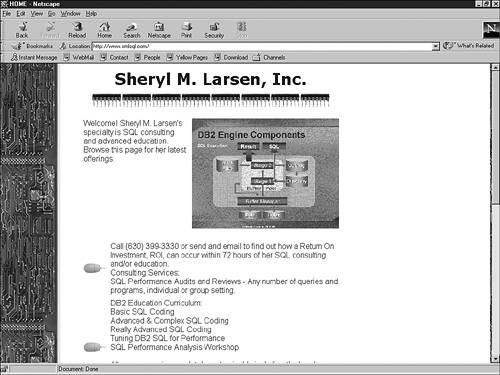 Several of the many DB2 user groups also have Web sites. These sites contain many useful DB2 resources, such as meeting schedules, newsletters, DB2 tips, and presentations. The IDUG Web site (see Figure 17.11) is one that every DB2 professional should visit regularly. It contains information on upcoming conferences, as well as an online version of its DB2-related magazine, IDUG Solutions Journal . Figure 17.11. The International DB2 User Group site. (http://www.idug.org) Figure 17.6. Eric Loriaux's MVS site. (http://www.loriaux.com/s390/)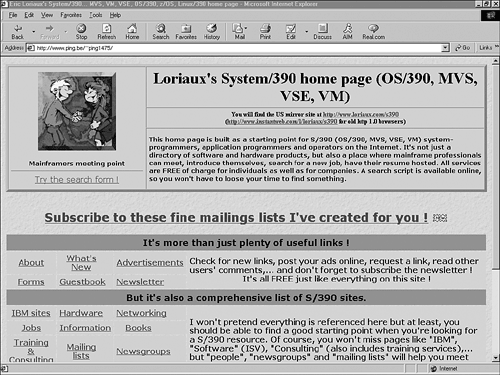 Figure 17.7. The DB2 Times site. (http://www.DB2Times.com)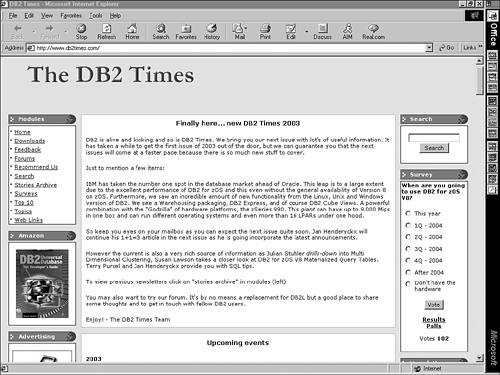 Another interesting site is provided by the U.K. DB2 Working Group (see Figure 17.12). This site contains some useful DB2 shareware and informative hints and tips from DB2 experts. Figure 17.12. The GSE U.K. DB2 Working Group site. (http://www.gseukdb2.org.uk) Another Web site worth reviewing on a regular basis is the DB2 Magazine site (see Figure 17.13). DB2 Magazine is published quarterly and the publisher makes the contents of each issue available online. Articles from past issues are available as well. IBM is a sponsor of DB2 Magazine, but it is independently published by Miller Freeman, so the content is usually up-to-date, technically accurate, and mostly non- biased . Figure 17.13. DB2 Magazine Online site. (http://www.db2mag.com)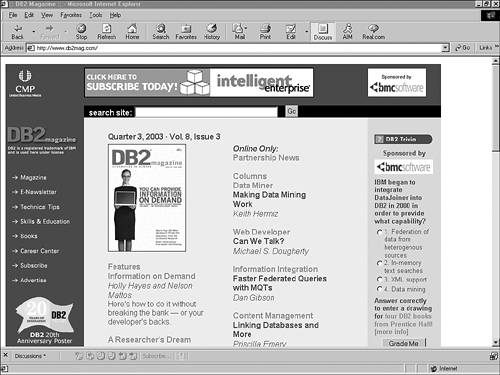 Finally, most of the third-party DB2 tool vendors also have Web sites. For an example, see Figure 17.14. In addition to information about their products, vendor sites often provide useful DB2 information such as tips, white papers, and newsletters. Refer to Chapter 39, "Components of a Total DB2 Solution" and Appendix B "DB2 Tool Vendors," for information on DB2 third-party tools and vendors . Figure 17.14. The BMC Software site. (http://www.bmc.com)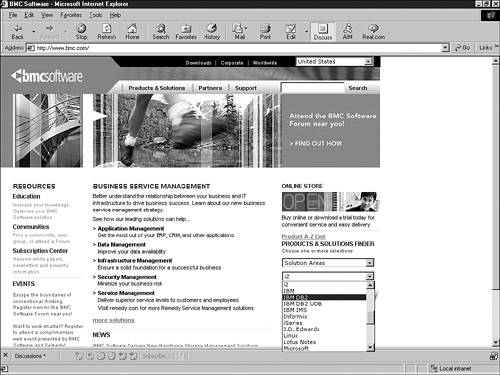 Internet GuidelinesThe following helpful guidelines can make your search for DB2 information on the Internet easier and more rewarding . Newsgroups Versus Mailing ListsA newsgroup can only be viewed using News Reader software. You only need to point and click with most News Readers to view the contents of a newsgroup. A mailing list is an email server. Notes are automatically forwarded to everyone on the distribution list. All you have to do is read your email to access the information. When a mailing list is mirrored to a newsgroup, use the newsgroup instead of the mailing list. Managing hundreds of emails from multiple mailing lists can be difficult. When the email is mixed in with other email messages in your in-box, it is difficult to keep up-to-date with the mailings . However, you can use a News Reader to read the newsgroup at your convenience. Interesting posts can be saved as text files. Consider Digesting Mailing ListsMany mailing lists offer the capability to accumulate messages and send them as one big email. This is known as a digest. The benefit is that instead of receiving multiple daily messages from a mailing list, only one daily digest is sent. To request digesting, simply send an email to the subscription address requesting a digest. The digest request must be made after you have successfully subscribed to the mailing list. For the DB2 mailing list, send the following message to the subscription address, LISTSERV@IDUG.ORG: SET DB2-L DIGEST The drawbacks to digests are that threads can be hard to follow, it is difficult to respond to messages, and they can become quite large. Read the ArchivesContributions sent to the DB2 mailing list are automatically archived. You can get a list of the available archive files by sending the following command to LISTSERV@IDUG.ORG: INDEX DB2-L The files returned can be ordered using the following command: GET DB2-L LOGxxxx If Privacy Is an Issue, Conceal Your IdentityIt is possible for others to determine that you are signed up to the DB2 mailing list by using the review command. This command sends the email address and name of all subscribers to the requester. To block your name and address from appearing in this list, issue the following command: SET DB2-L CONCEAL Be Skeptical of Information Found on the InternetBecause the Internet provides access to anyone with a computer and a modem, the information received can be less than reliable. It is quite common to post a question and receive multiple, conflicting answers (usually, the answers range from "yes," to "no,"to "maybe, if ," to "that question is not appropriate for this newsgroup"). Always use common sense before trying any posted tip, trick, or technique that seems dangerous. It probably is. Avoid Cross-PostingCross-posting is the act of posting a single message to multiple newsgroups. Cross-posting is considered impolite and should be avoided. When a post is sent to multiple newsgroups, the cross-posted threads are difficult to read, usually off-topic, increase network traffic, and reduce the quality of the newsgroup discussions. Know and Use EmoticonsEmoticons are drawings composed of text characters that are meant to look like a face expressing an emotion (hence the name emoticon). They are used on the Internet because it is difficult to convey emotions using text-based media such as email and newsgroups. The following are a few of the most popularly used emoticons:
Read the FAQsFAQs (Frequently Asked Questions) are documents defining the focus of a newsgroup and answering the basic questions that most new users always ask. Be sure to read the FAQ for any newsgroup before posting to it. Unfortunately, the DB2 newsgroups do not have FAQs. Use the Internet FAQ Consortium Web page (shown in Figure 17.15) to find Usenet FAQs. Figure 17.15. Internet FAQ Consortium. (http://www.faqs.org) Avoid FlamesFlames are posts that are hostile , rude, or otherwise confrontational. Just as these things are not proper to do in person, they are improper on the Internet, as well. It is usually best to ignore flame messages. Do Not Respond to SpamsThe term spam is used to describe junk emails and postings that are off-topic, commercial, or otherwise violate good taste. When you receive a spam, just ignore it. Posting a long, nasty response to the spam back to the newsgroup or mailing list is just as inconsiderate as the original spam. Basic Newsgroup TipsBefore reading and responding to Internet Newsgroups, you should familiarize yourself with the Internet in general, and each Newsgroup specifically . The following tips will ensure that you effectively utilize Internet Newsgroups:
Use the List of ListsThere are over 30,000 public mailing lists available on the Internet. Of course, there are many more private mailing lists that are not open for public enrollment. Finding the appropriate list can be a daunting task. Fortunately, Tile.Net can help. Simply point your web browser to http://Tile.Net/ and you will have access to a nice interface for finding information about discussion and information lists, Usenet newsgroups, and useful FTP sites. Additionally, you can subscribe to a mailing list for information about new and updated mailing lists. This is called the new-list and can be subscribed to by sending the following to listserv@vm1.nodak.edu: subscribe new-list Craig Mullins Substitute your name where I specified Craig Mullins. Develop a List of BookmarksWhen you find a Web page that has useful information, use the bookmarking feature of your Web browser to record the URL for later use. Use Search Engines on the WebThere is a wealth of information available on the WWW that will make the job of a database developer, database analyst, system programmer, or DBA much easier. However, finding all of it can be quite a task. Developing a list of bookmarks, while useful, can be difficult to create and even more difficult to maintain. Web sites are constantly moving, dying, and coming online. It is impossible for a bookmark file (which is a static file containing links to other sites) to remain accurate for any length of time. Instead of hunting and guessing for information resources, you can use a Web search engine, instead. There are quite a few search sites available, including Yahoo!, Excite, and Google. These sites are designed to accept search keywords as input and return links to Web sites that contain information related to the keywords. With a search engine, the user types in a word or phrase (such as database or DB2 ). The response will be a listing of links to sites that match the search. The most popular search engine is undoubtedly Google ”shown in Figure 17.16. Figure 17.16. The Google Search Engine site. (http://www.google.com) |
| < Day Day Up > |
EAN: 2147483647
Pages: 388